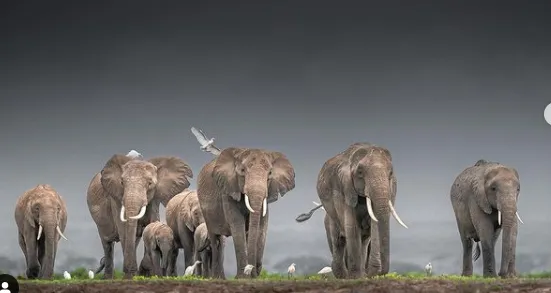Refugee in their own habitat- The shifting dynamics of Indian elephants because of climate change
Independent journalist Shruthi Mohan says the survival of elephants depend on regular migration over long and diverse regions in search of food, water and reproductive partners.
In early March this year, a 55-year-old man was trampled to death by an elephant at the Rajaji Tiger Reserve in Uttarakhand. The deceased was on his way to the nearby Neelkanth shrine. This came on the heels of another attack in February, when an elephant killed another person at Phoolchatti road near Neelkanth shrine-Lakshman Jhula area in Pauri Garhwal district of Uttarakhand. This jumbo also barged into nearby shops and destroyed a transport van.
This increasing trend in Elephant-human conflicts in India and across the globe is worrisome. But should we settle down to blaming these mammoth creatures or is there more to these incidents than what meets the eye?
In 2019, a study published by the journal Frontiers in Diversity and Distributions under the topic “Predicting range shifts of Asian elephants under global change”, emphasised that climate change will prompt a redistribution of species- directly through temperature conditions and access to water, and indirectly through habitat modification. It predicts that with the current scenario, the Asian elephant’s range of habitat is likely to shift towards higher elevations in the Himalayas. This is further proven by frequent elephant sightings in Uttarakhand, as recent as during the Covid lockdown in July 2020.

Image Credits: Varun Aditya
The adversity of climate change
According to the World Wildlife Fund, the traits that make elephants vulnerable to changing climate are “ a declining population size, sensitivity to high temperatures, invasive plant species outcompeting their regular food sources, and disease susceptibility.”
The study further adds that the variables impacting the redistribution of elephants are driven by - land-use change, water balance in the climate, temperature change and human-induced disturbances.
It is estimated that climate change and human pressure will together impact human-dominated regions which are geographically at lower elevations pushing for extreme arid conditions.
This will in turn impact the living conditions of elephants pushing them to seek refuge at higher elevations with better water availability. With deteriorating climatic conditions, the gap between each monsoon season will be longer, impacting the summer precipitation severely by the end of the 21st century. This monsoon fluctuation will directly impact climate water balance and vegetation patterns. Elephants, who depend on land for forage and water, will face an immediate threat.
Most of the climate change solutions are often force-fed through Government and policies in a top-down approach. But for Govind Gorur, who is a captive elephant care provider and an environmental educator, the narrative around this issue must change.
He says, “Politicians who are hardly interested in animals are fed these terms of elephant-human conflict by the media. With climate denial at his dispersal, no politician will dive deep into addressing this issue and will always blame it on climate change. So, the narrative must change, else the forest depletions under the garb of development will always be pursued. We must first define what a ‘forest’ is, what are the living conditions needed for these animals to strive for. If and only if we as a larger population take ownership of saving our forests and green cover is when the Government and policies will stand up and take a note.”

Image Credits: Varun Aditya
Elephants- the most intelligent animal
The International Union for Conservation of Nature (IUCN) lists Asian elephants (Elephas maximus) as endangered since 1986. India and Nepal is home to more than 60 percent of Asian elephants.
In India, the Asian elephants were once scattered across the country. However, currently, they are found in four distributed populations across north, north-east, central and towards the south of India. Their habitat varies from a wet-tropical evergreen forest to semi-arid thorn and scrub forests.
But the highest population of elephants are found in tropical deciduous forests. The survival of these long-lived animals depends on regular migration over long and diverse regions in search of food, water and reproductive partners.
These jumbos are categorised under ‘megaherbivores animals who seek forest land that is rich in food and water to survive. Elephants can eat up to 450 kg of food every day.
However, the growth of human habitats and agricultural fields has led to a widespread loss of elephant habitat, degraded forage, reduced landscape connectivity. While this habitation shrinks, these jumbos are forced into closer contact with human and human settlements resulting in more severe conflict owing to space and resources with a direct impact on crop raids and loss of life, reads a research journal published on frontiers on Ecology and Evolution (https://www.frontiersin.org/articles/10.3389/fevo.2018.00235/full).
Why are elephants important for the ecosystem?
Like in every habitat, where each animal restores the biodiversity around, elephants too play their part. During the arid and dry season, elephants dig for water using their trunks. This in turn helps them beat the heat and helps other animals to quench their thirst.
These large animals with higher dietary requirements play an important role in seed dispersion, so much so that some fruit-bearing trees completely rely upon elephants for this process. Elephant dung is also a primary seed disperser when the seeds of some trees remain undigested in the excreta which further leads to germination, thereby boosting the ecosystem.
By calling it a human-elephant conflict, are we addressing the issue?
Human-animal conflict can be defined as a direct threat posed by animals towards the livelihood or safety of people, which further leads to persecution of the species itself. Although human beings and animals have coexisted for millennia- this conflict has become a global concern owing to its frequency and its serious impact.
This conflict is not limited to only elephants but affects other species such as tigers, leopards, deer, sharks, rhinos, crocodiles, seals and so on. This interaction often severely impacts the security, livelihood and well-being of the people from whom we seek support for wider conservation goals.
According to the World Wildlife Fund, up to 300 people may be killed annually in human-elephant conflicts. The impact of this conflict is often huge, resulting in loss of crop, livestock, property and sometimes human life. Elephants, which are already threatened are often killed in retaliation to avoid future conflicts.
Apart from affecting those who share the immediate habitat, often human-animal conflicts impact nations that are trying to align with and benefit from, rich biodiversity and conservation programmes.
Dr P.S. Easa, who has worked extensively with the Department of Wildlife for about two decades, says “Every time an elephant-human conflict happens, data is thrown over saying so many animals killed so many humans and vice versa. But it's important to go beyond statistics.
This is not a wildlife issue alone, but it is a social issue. The social aspect of such conflicts is not spoken enough. What is often not measurable is the social impact on the people affected, especially the downtrodden like the tribals and villagers. The psychological impact is long-term.”
Addressing human-elephant conflict becomes a complicated affair because its underlying cultural, political and economic aspects that shape these conflicts are often very complex and poorly understood.
Many such repeated interactions prove that every conflict is unique in its way making it difficult to incorporate easy and transferable solutions. But this situation also brings to the forefront the importance of interdisciplinary approaches which help in mitigating such conflicts with adequate skills and resources.
Govind further adds that “If we really wish to help these mammoths there are only two ways. First, increase the tree cover in forests which will thereby limit their movement and provide them with their essentials. Secondly, form communities at the forest boundaries who will then be your ally in addressing this issue. Provide elephants with the food they need, call it to feed farming and draw those boundaries.”
Adding to this, Assam based tea farmer Tensing Bodosa who has built an elephant-friendly tea farm says,” because of depleting climatic conditions and excessive land use, the grasslands and fruit-bearing trees are disappearing. This change is forcing elephants to barge into the farms on the lookout for food. By creating a green patch at the elephant entry point, we can mitigate this issue without causing much harm. By doing this there is a sense of co-existence between us and the elephants too”.
Can India save its national heritage animal?
Though countries with rich biodiverse grapple with this issue, almost every country in the world is home to some form of human-animal conflict because of climate change, thereby highlighting its importance in national policies and strategies for wildlife.
Climate change is a bitter reality for humans, but it has now started to affect the living conditions of elephants too, who are dominating creatures with strong, cultural and religious significance.
In India, the history of these jumbos dates to 4,000-5,000 years, which makes it more convenient to garner public support and attention, thereby pushing for their conservation. It is time that we take ownership of our actions, invest in long-term solutions to contain climate change, and create a conducive environment for these animals to strive.
Edited by Anju Narayanan
(Disclaimer: The views and opinions expressed in this article are those of the author and do not necessarily reflect the views of YourStory.)







